Carbon is notoriously difficult to recycle, energy-intensive to produce, and does not biodegrade. Looking in our bike shed, there is a lot of carbon; frames, wheels, rigid forks, handlebars, stems, shoes, bottle cages, and even helmets are made using composites. That’s because carbon fibre is strong, lightweight, and can be tuned to dampen vibration, while also providing stiffness in one direction and flex in another.
So back in May, when an article from Reuters floated into our Facebook feeds, detailing a new composite recycling process pioneered by a Danish company to reprocess decommissioned carbon wind turbine blades, our interest was piqued.
The details are light into the nuts and bolts of the process; however it says chemicals are used to separate the resin from the fibres, returning each into a usable product “similar to the virgin materials.”
Given the number of composites used in bikes, parts and accessories, we were curious what happens to all of this material once we are finished with it, and if the industry could utilise pre and post-consumer waste composites. So, we spoke to researchers from Sydney University, the Australian National University and industry vets from Pivot, Revel Bikes and SRAM about carbon recycling and how they are trying to green up composites.

Sentenced to life in a landfill
Beyond the manufacturing waste and energy needed to create thermoset carbon components, the materials simply don’t break down over time, meaning that a broken frame, or wheel is likely to sit in the landfill for a lifetime.
“They don’t biodegrade, which is why we use them a lot in the aerospace industry and the wind power industry. They are anti-corrosive, carbon fibre doesn’t degrade, and epoxy resin is pretty stable in the environment, so if you dispose of them in a landfill, then it will remain there for a long time,” says Andy Hi, a PhD candidate working with composites at the Australian National University in Canberra.
As far back as 2016, the Australian National Waste Report identified composite materials as a growing problem that would create hurdles in the future if we don’t take action. Of course, the bike industry and consumer goods, in general, are a drop in the bucket compared to what’s coming out of the aerospace industry and others like it, but we do have an eyesore on our hands, and it’s getting bigger.

“There are piles of broken carbon frames and wheels behind the factories that make bikes in China and Taiwan. There are literally city blocks worth of broken bikes, that were discarded due to quality control issues, and they’re just sitting there,” says Adam Miller, the man behind Borealis, Why Cycles and Revel Bikes.
The bike industry as a whole has never been more focused on sustainability and reducing its carbon footprint (pun intended); bike brands are reducing single-use packaging used to ship bikes, brands like Muc-Off are selling powdered refills of bike cleaner to reduce plastic use, Bontrager and FiveTen are making things from reclaimed fishing nets and clothing brands like Patagonia, Rapha and Velocio will even repair damaged MTB kits to keep you riding in them longer.
But what about all of this carbon fibre? People are constantly upgrading their bikes and breaking rims, and many carbon components end up in the bin, so what is the bike industry doing with all of this material?
Related
- Roval Control Carbon Wheel Review | Astonishingly light, reassuringly solid
- How Canyon built its lightest ever carbon mountain bike
- What does native logging mean for mountain biking in Derby?
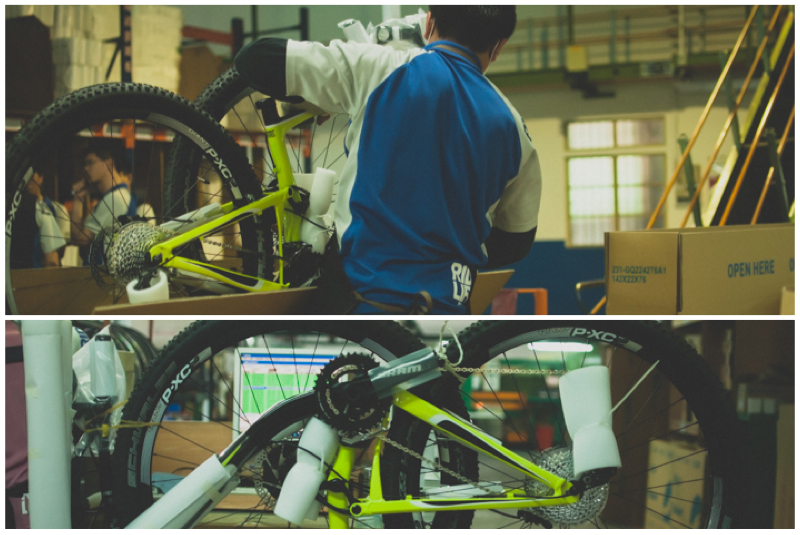
The problem with carbon fibre recycling?
When most materials are recycled, whether that be aluminium cans, plastic bottles or even paper, the first step is to drop the refused material into a shredder. However, this presents a problem for carbon, because its utility as a structural material comes from the length of the fibres, and freeing them from the epoxy resin isn’t as simple as turning up the heat.
“Carbon fibre is extremely hard to recycle because other materials like steel and some plastics, you can reform or recycle by simply grinding them up and melting them. The advantages you get from composites depend on the shape of the fibres, the architecture (layup), and the characteristics of the fibres themselves. If you disrupt those characteristics (by putting them through a shredder), then you won’t get much benefit from the recycled materials,” says Dr Ali Hadigheh, a researcher at The University of Sydney and a newly minted mountain biker himself.
As it stands, there are two main ways to recycle carbon: pyrolysis and solvolysis.

“Ideally with pyrolysis, you want to burn off the resin and reclaim the fibre undamaged. But during this burn-off process, if it gets to a high temperature and it’s (the burn) not controlled well, it can cause damage to the actual fibres itself,” says Hi. “Sometimes, if the fibre gets hot enough during the burn-off process and it reacts with oxygen, it can damage and put defects onto the carbon fibres. In that case, when you get the recycled fibres, they could be a much lower strength or stiffness compared to new carbon.”
The other major method of composite recycling, solvolysis, uses chemicals to release fibres from the epoxy.
“With these low-temperature chemical processes, you use a solvent to dissolve the resin, and you can typically recover the fibres with less damage compared to the thermal process. But again, you are using very concentrated acids, and you’re creating a lot of waste acids, which need to be treated (before they can be disposed of). This has a greater environmental impact than the thermal process.”

Miller tells Flow back in 2015, when Revel was in its infancy, several of the factories he approached had the capability to incorporate recycled carbon, but it would double the cost of the bikes, and he wasn’t sure it offered any environmental benefit.
“Where there are ways to recycle carbon fibre, usually you burn off the epoxy — burning epoxy is awful. Most carbon factories don’t have a good air purification system, and the workers have masks on, but you still breathe in atomised carbon bits which is not good. Even when the epoxy is not on fire, it can still cause cancer,” Miller says. “So when you burn it, it’s terrible, and regardless of whether there is a great Environmental Protection Agency in Taiwan, or China, or the US, burnt epoxy in the atmosphere is not good for the environment. So it’s kind of like, okay, what are you really helping here.”
Worse still, if the fibres come out of the recycling process un-damaged, they aren’t usable in the same way. When the carbon goes through the extruder, the architecture and weave are pulverised, Hi compared what comes out to hair on the floor of a barbershop. So what started as a unidirectional piece of carbon that flexed in one plane, but not another, is now a multi-directional cotton ball that can be used to create a strong and durable fibre reinforced structure but loses a substantial amount of tuneability.
Improvements in carbon recycling
As it stands, the widespread methods for recycling carbon fibre leave quite a lot to be desired when it comes to their cost, the usability of the product they produce, and the impact of the resources needed to facilitate the process. Luckily, there are some brilliant people around the world trying to improve this process.
One of these intrepid researchers is Hadigheh, and his team at The University of Sydney has pioneered a method of pyrolysis that has returned high-quality carbon fibres.

“We want our material to have high strength after recycling and to keep its shape, so the method that we developed, we used currently available methods in different industries to optimise pyrolysis and the oxidation process,” Hadigheh tells Flow.
“Pyrolisis is basically removing and degrading the (bonding) material using heat, so we did the thermal decomposition of the composite in an inert atmosphere — we did it under nitrogen — to a specific temperature, and then we oxidised the composite to get a very clean and pure carbon fibre. With lots of methods, you won’t get clean fibres, but with this method, we did,” says Hadigheh.
“This is important because when you want to make a remanufactured composite from recycled carbon fibre, if you have any impurities, like char, on the surface of the carbon fibre, then it’s not impregnated with the epoxy properly, and then you have a weak point within your composition.”
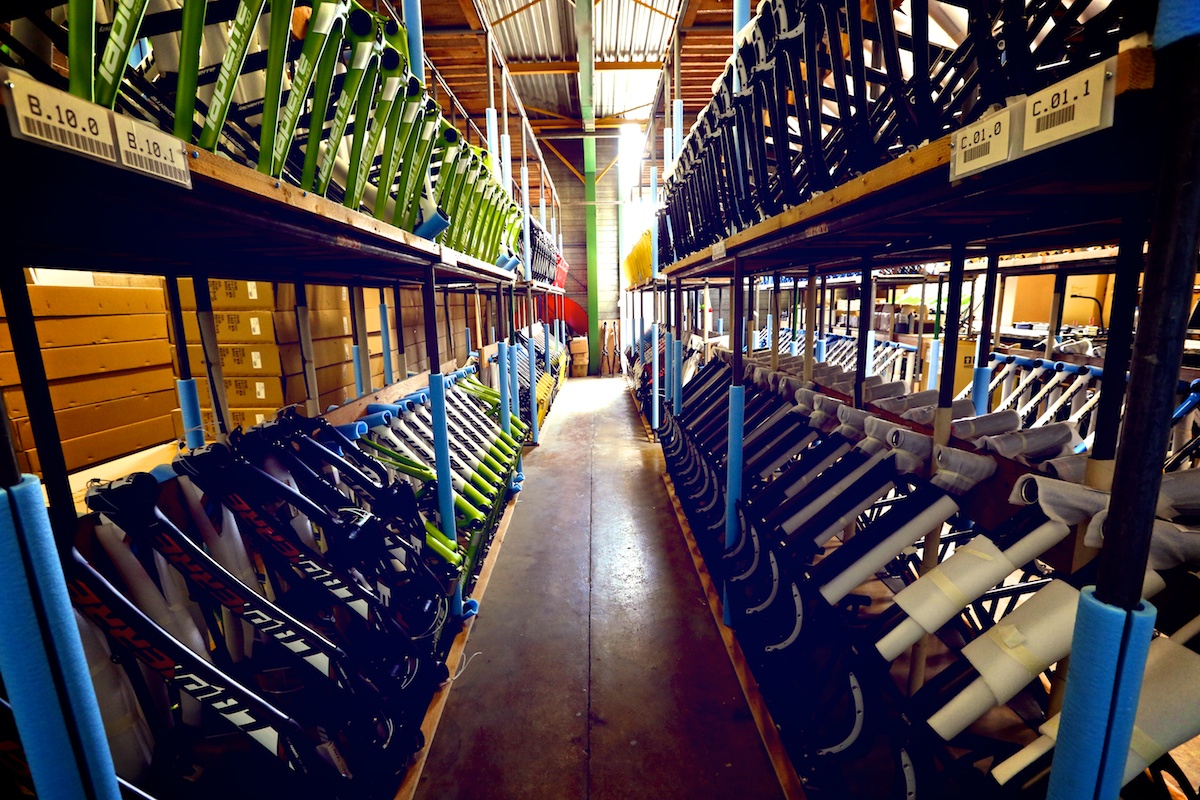
Hadigheh notes that pyrolysis is the most researched method for carbon recycling, and innovations in this area can easily be scaled to an industrial level. He told Flow that in among conversations to process wind turbine blades and aerospace components, an Australian bike company that works with carbon had reached out interested in sending samples to see if this method was viable for recycling bikes. He wasn’t able to elaborate on exactly who this was, so we are left to speculate.
Hi also told Flow about a group of researchers who are using water jets to realign recycled fibres, transforming that ‘hair on the floor of a barbershop’ into a more usable product.
Fusion Fiber and thermoplastic mountain bikes
But it’s not just in university laboratories where leaps in reclaimed composites are taking place. Joe Standish is the former VP of Operations at ENVE composites and is now running a startup called CSS Composites. He’s also a long-time friend of Miller’s and approached him with a new thermoplastic composite he was working on called Fusion Fiber.
“The actual carbon fibre strands are exactly the same as what is used in thermoset frames and wheels already on the market. We use all Toray and Mitsubishi, which are the best of the best brands of raw carbon fibre,” he says. “With Fusion Fiber, the bonding agent is what’s different; we use a nylon polymer instead of epoxy.”
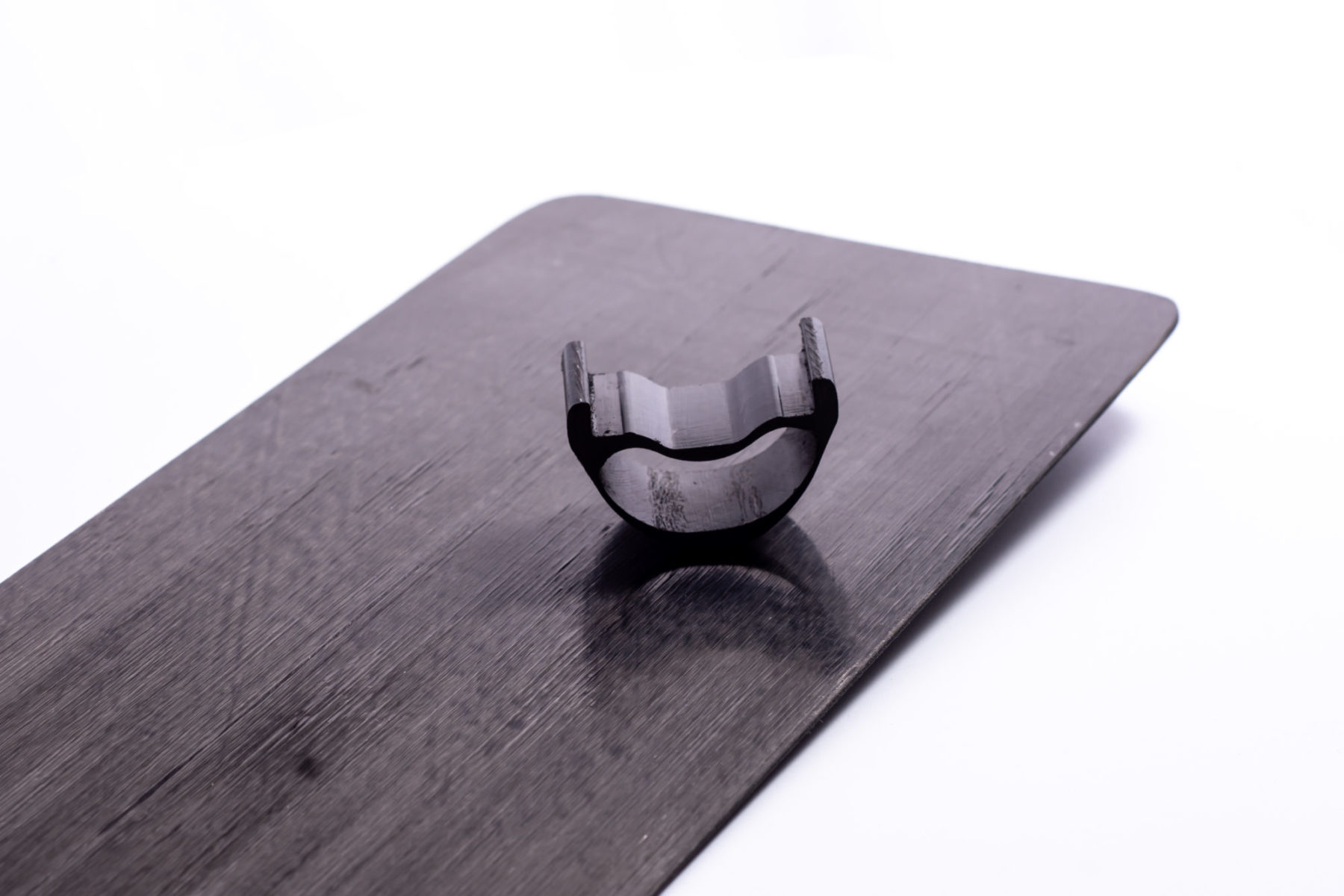
According to Miller, the nylon bonding agent is an order of magnitude less brittle than epoxy, and dramatically improves impact resistance and vibration damping — we haven’t ridden a set of these wheels yet, so we’ll have to take him at his word for the time being. Beyond the purported ride performance, Miller wanted to start working with Fusion Fiber because the nylon polymer greatly simplifies the recycling process.
“If you break a rim, it goes into the chipper and gets broken up into these little fibres and thrown into a bin. When there is enough of it, we heat the contents up to about 500-degrees (Farenheight) and it all melts together and becomes a big chunk,” says Miller.
Miller also says manufacturing offcuts and even the dust from drilling spoke holes is all thrown into this recycling bin to be made into something else.
As a proof of concept, Revel took all of the material used during the prototyping process and made tyre levers, and the brand is experimenting with manufacturing processes ranging from injection moulding to stamping, forging and even CNCing recycled Fusion Fiber. Because the fibres have been cut up, you won’t be able to make a frame, a wheelset or handlebars from the reclaimed carbon, and Miller says they are working on producing suspension linkages, stems, seat collars, chain guides, frame protection and a host of other non-bike related products.
Flow asked Miller if we could expect to see frames made using this new pre-recycled thermoplastic carbon. He said he was “unable to confirm or deny” but with the worst poker face we have ever seen.
The other major factor that convinced Miller Fusion Fiber was worth the risk was the energy consumed during manufacturing.
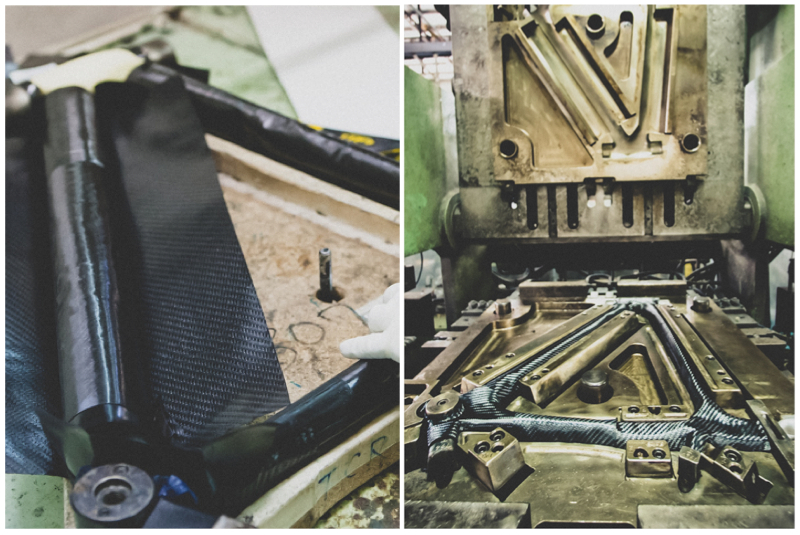
“A standard thermoset rim made using epoxy goes into a mould and cooks for 45-minutes at 350 degrees,” says Miller. “The Fusion Fiber rims go into the mould, and it’s like a flash cure. It takes about 20-seconds, and you pull them out, put stickers on them, and they get shipped to the customer — they don’t need any finishing or sanding.
So significantly less energy goes into making them. We haven’t done all the math to say how many tonnes of CO2 does this save, but it doesn’t take a rocket scientist to work out 20-seconds of curing vs 45-minutes is massive.”
Revel isn’t the only brand experimenting with this type of thermoplastic material. Fellow Colorado-based brand Guerilla Gravity is making frames from Revved Carbon, which is also a nylon-based thermoplastic, that is manufactured using a similarly truncated curing process and can also be more easily recycled than thermoset epoxy-based carbon.

Dealing with manufacturing waste and cleaning up the factory floor
But it’s not just end of life composites that are the problem; let’s not forget a carbon frame or rim starts its life as a rectangular piece of fabric, that is cut into oblong shapes to create a tube. Just as the fashion industry has an ongoing issue with waste generated from cutting designs off a spool of cotton fabric, the bike industry is fighting the same battle with carbon scraps.
John Pentecost, the co-founder of Evil Bikes and e*Thirteen, who has worked at Yeti, Race Face and has landed at Pivot, tells Flow they are motivated to eliminate waste from both an environmental impact and a cost perspective, because offcuts are dollars down the drain.
“Our layups are optimised to only add material where it’s critically needed to enhance strength and stiffness, and we use some pretty complicated algorithms to make sure our plotters cut in patterns to minimise waste,” he says.

Chris Mandell, a Product Manager at SRAM, tells Flow, “The amount of waste depends a lot on the geometry of the parts being produced. If we were making square blocks, we’d use nearly 100% of the prepreg sheets. But for some bike parts, the waste could be as high as 35%. This kind of waste is harmless, but it lasts a long time. Carbon material is expensive, we want to increase this percentage and find a viable use for the scrap that we are not able to eliminate.”
This is why SRAM recently filed a patent for recycling prepreg scraps. The most common method for recycling manufacturing waste is to shred it, heat it up and stir it all together into a slurry. The trouble with this process is the smorgasbord of scraps contain all different types and amounts of resin, which leads to a variable quality product that doesn’t perform exceptionally well, nor does it look very nice.
According to the patent, SRAM’s new method uses ‘reactive and non-reactive diluents’ to separate release paper used on prepreg sheets, and facilitates chemical reactions to prevent mutual repulsion — too many positively charged electrons, negatively affecting bonding. The result is a resin carbon fibre mixture that can be used in low-stress areas on the bike, as filler, or on-sold to a different company to make something like car bumpers or truck beds.
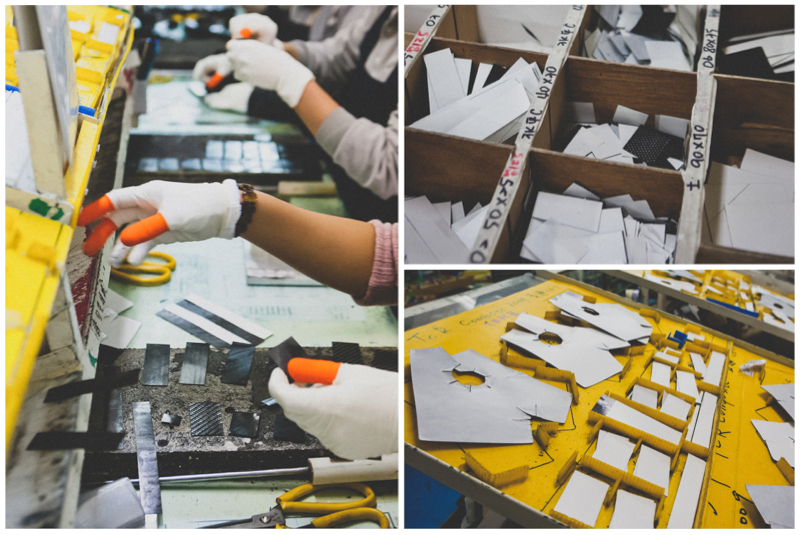
Putting things in perspective
Carbon is not great for the environment, for that matter, so is manufacturing tyres, and there are some nasty ingredients in a few prevalent chain lubes. But before you jump into the comments and tell us how you chose an aluminium bike because it’s so much greener, pop over to google earth and type in ‘Lac de Bauxite Chicoutimi Quebec.’ Here you’ll find a bauxite slag field created by Rio Tinto as it renders bauxite into alumina, and then to aluminium. The point here is that almost all industries leave a mark on the environment, and folks inside the bike industry are working on these things.
“It’s one thing to look at decommissioned aeroplane fuselages and figure out what to do with a huge amount of material like that; it’s quite another to look at a bike frame that weighs less than two kilos and try to develop infrastructure to properly recycle or dispose of it,” says Pentecost. “Unfortunately, some of the advancements in carbon bike recycling that looked like they were developing on the near horizon seem to have taken a bit of a back seat to COVID. We do anticipate carbon recycling becoming a normal part of the process, but it still may take another year or two,” says Pentecost
“There’s more work to be done for sure, but I’m confident we (and the industry at large) are taking steps in the right direction,” he says.
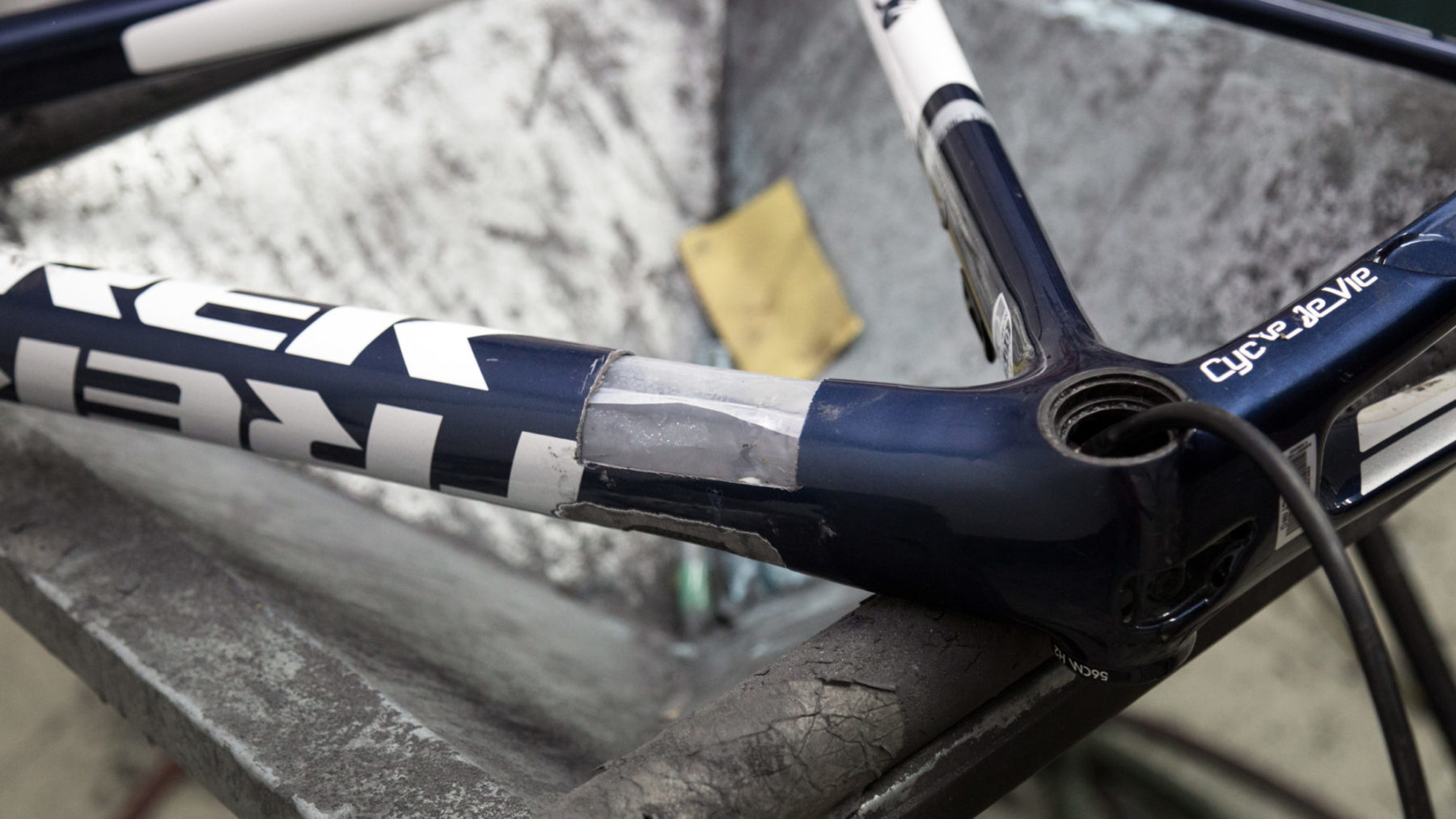
Both Miller and Pentecost said their respective brands and manufacturing partners are taking steps to clean up their acts in other ways. Both brands use post-consumer and recycled materials to pack bikes and have stopped using the plastic bags usually hidden in every bike box. Miller also tells us one of their manufacturing partners has swapped to using wax for internal frame moulds instead of plastic bags or styrofoam.
The waste created by the bike industry is minuscule compared to so many others, however just because we’re not the worst does not mean that we can’t strive to do better. There is still a lot of work to do, and dealing with carbon fibre is just one aspect of the wider issue at hand, but the folks working in the bike industry are a notoriously clever bunch, and we are waiting with baited breath to see what comes next.